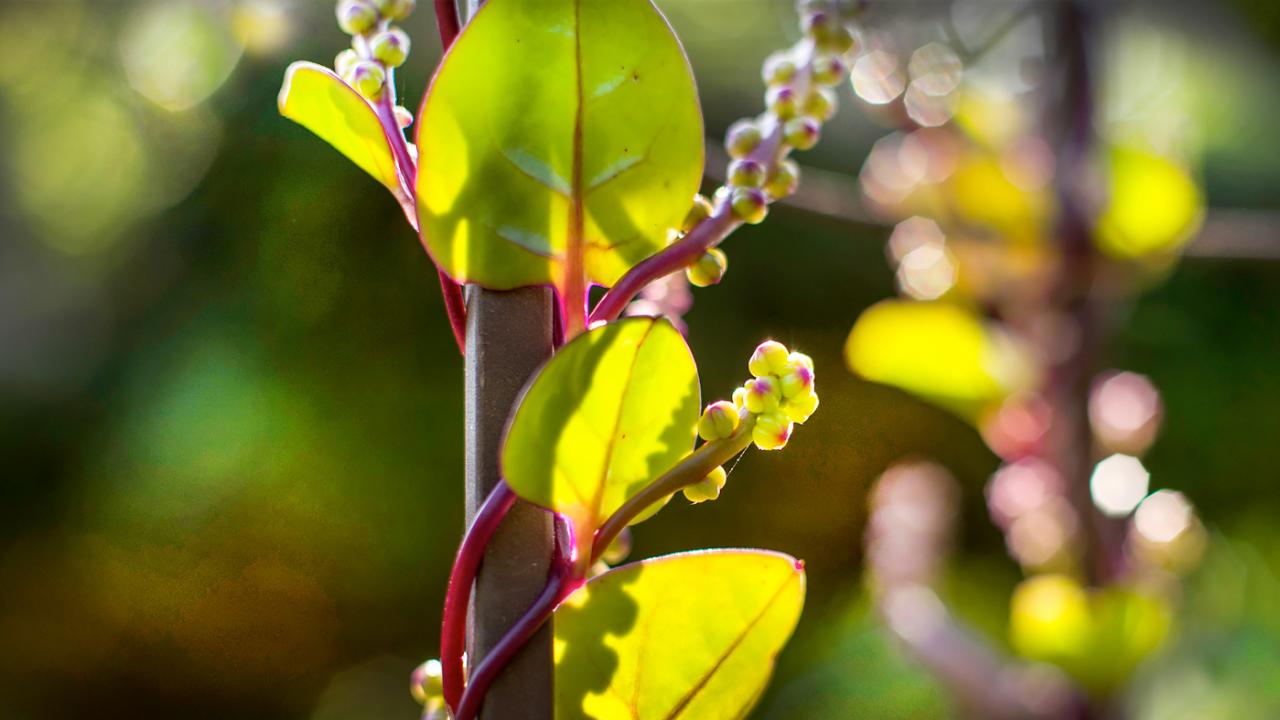

Plants & Gardening
Garden Stories
What is happening in the evaluation garden
Reflections on a season of blooms in plant evaluation garden
The Chicago Botanic Garden dedicates an entire garden to plant evaluation. But have you ever wondered how it works?
As we move into early fall, the Hibiscus will rebloom sporadically at the Garden’s Bernice E. Lavin Plant Evaluation Garden, but their big show is at an end. This applies more broadly to the other plants in the evaluation garden too.
The final set of blooms come from the grasses, which are putting on a spectacular show this year. As this change occurs, my job shifts slightly. Instead of trying to capture plants at their peak, I’m trying to capture the point that they start to detract from the landscape. This depends a bit on their surroundings but only to a certain extent. I’m prioritizing the plants that “pass with a vengeance” (e.g., Shasta daisies, coneflowers, and burnets). I’m less concerned about plants that just fade into obscurity because then they just provide room for something new and exciting to take their place.
Now that the garden is being less dramatic, more of my energy is being directed into cleaning and compiling data instead of gathering it. Part of this process includes writing year-end reports for our cooperators: those breeders, distributors, or other entities that have given us their plants to evaluate. As part of this, I’m thinking back on the year and there are several plants I want to highlight:
Echinacea ‘Postman’ BUTTERFLY™
‘Postman’ caught my eye because of how its flowers age. Both its new and old flowers hold their own against each other, and I’m really interested to know if this could be used in a design setting to play off plants that bloom for shorter periods and could complement the distinct colors of either the new or old blooms.
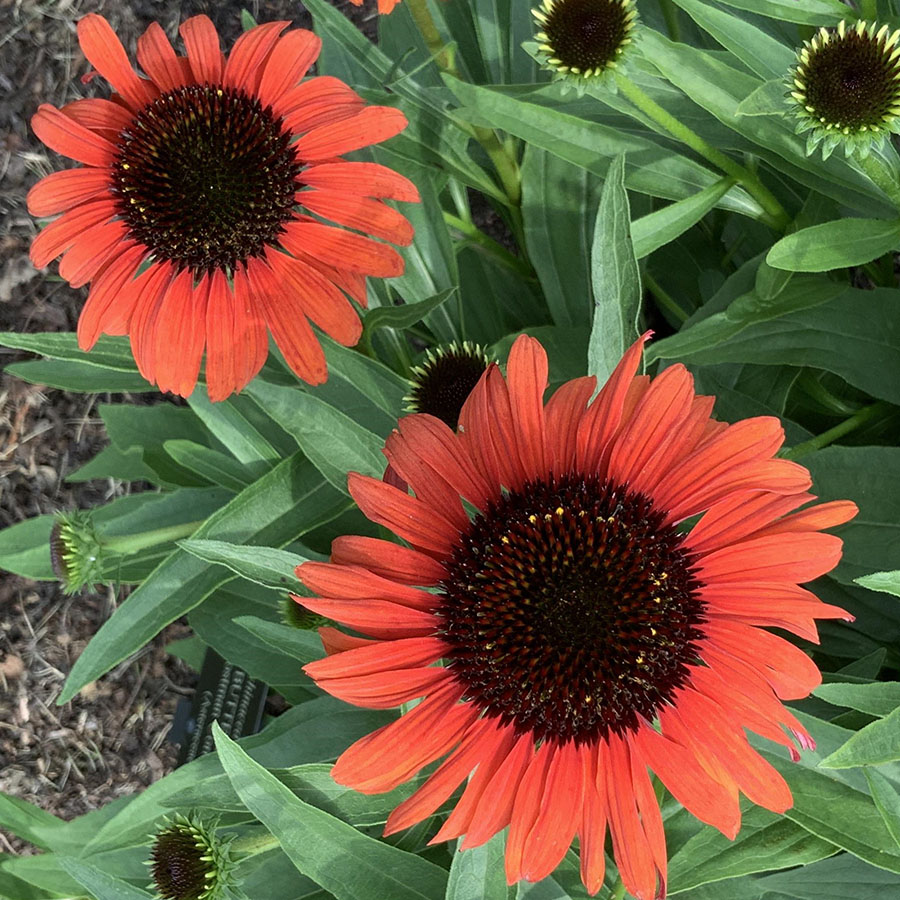
Size: 32” tall by 32” wide. Flower Size 3½” across. Blooming period: mid-June to mid-late August.
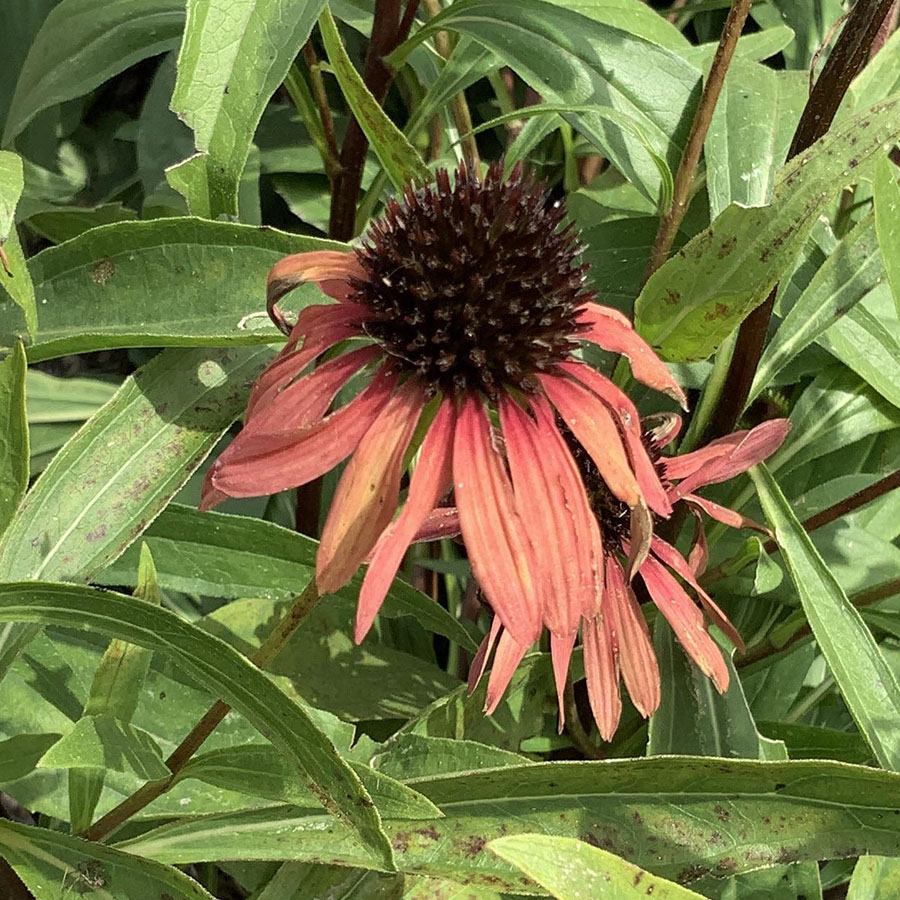
Hibiscus moscheutos ‘RutHib3’ HEAD OVER HEELS® ADORE
HEAD OVER HEELS® ADORE stood out to me because its foliage remained beautiful as it bloomed. The foliage is a light green, almost chartreuse, with subtle burgundy splotching. The thing that sets it apart is its layer of hairs that give it a silver sheen. The foliage combined with the plate-sized pink flowers are absolutely stunning.
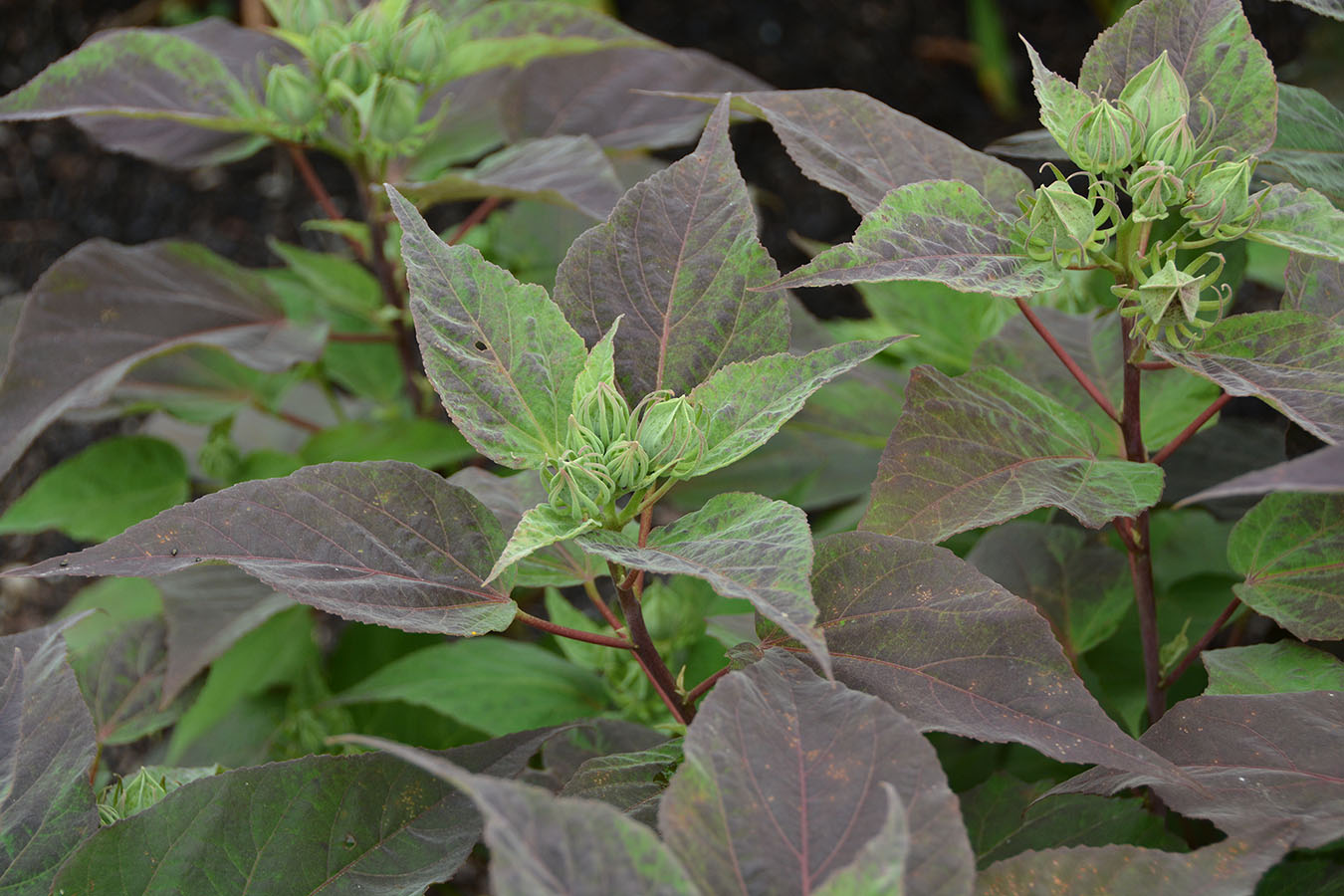
Size: 43” tall by 57” wide. Flower Size: 9” across. Blooming period: August (peaks mid- to late)
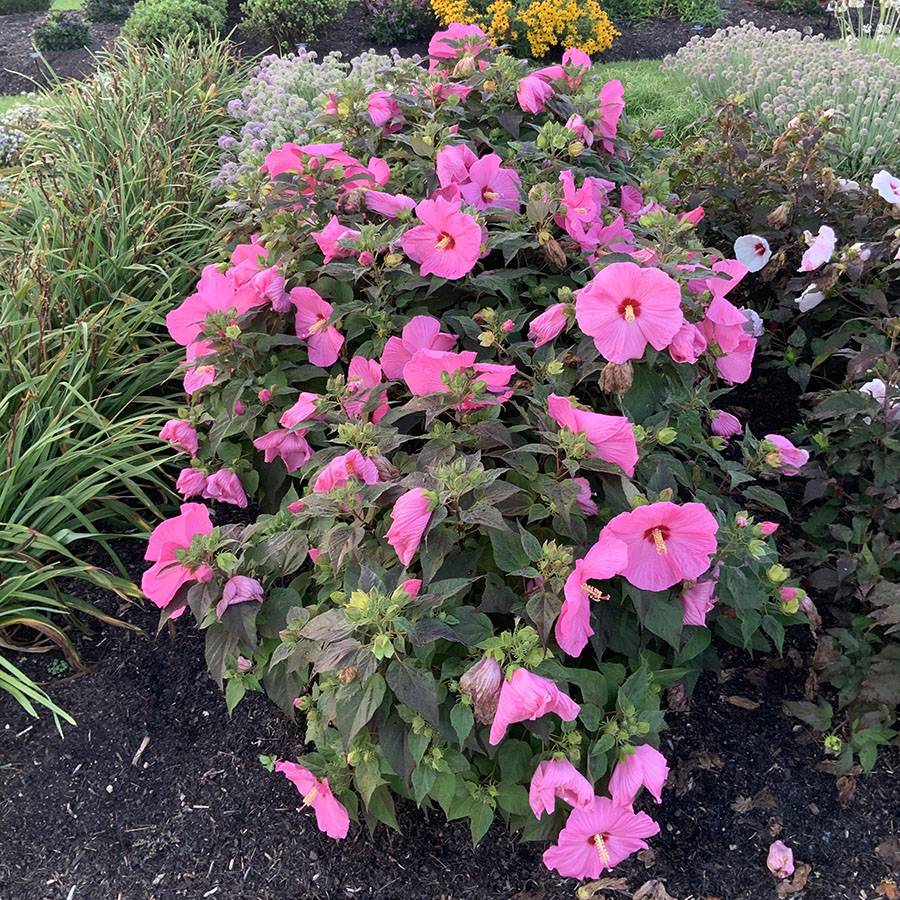
Allium ‘Serendipity’
‘Serendipity’ and the next plant, Leucanthemum ×superbum ‘Cream Puff’, perhaps rank highest on my list. ‘Serendipity’ produces a mass of purple spheres that almost seem to glow because of their hue and saturation. Then they get fluffy as they open, and the fuzziness is supplemented by the constant cloud of bees surrounding each orb.
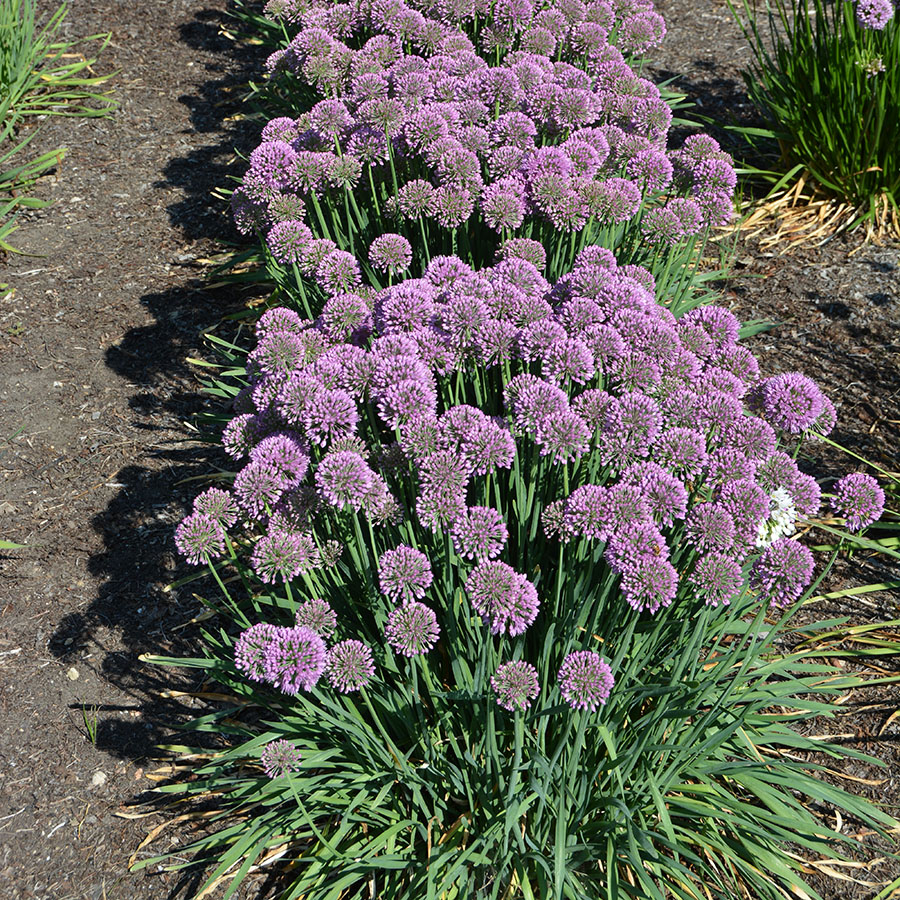
Size when blooming: 24” tall by 27” wide. Flower size: spheres measure 1¾” in diameter. Blooming period: Late July to early, mid-August
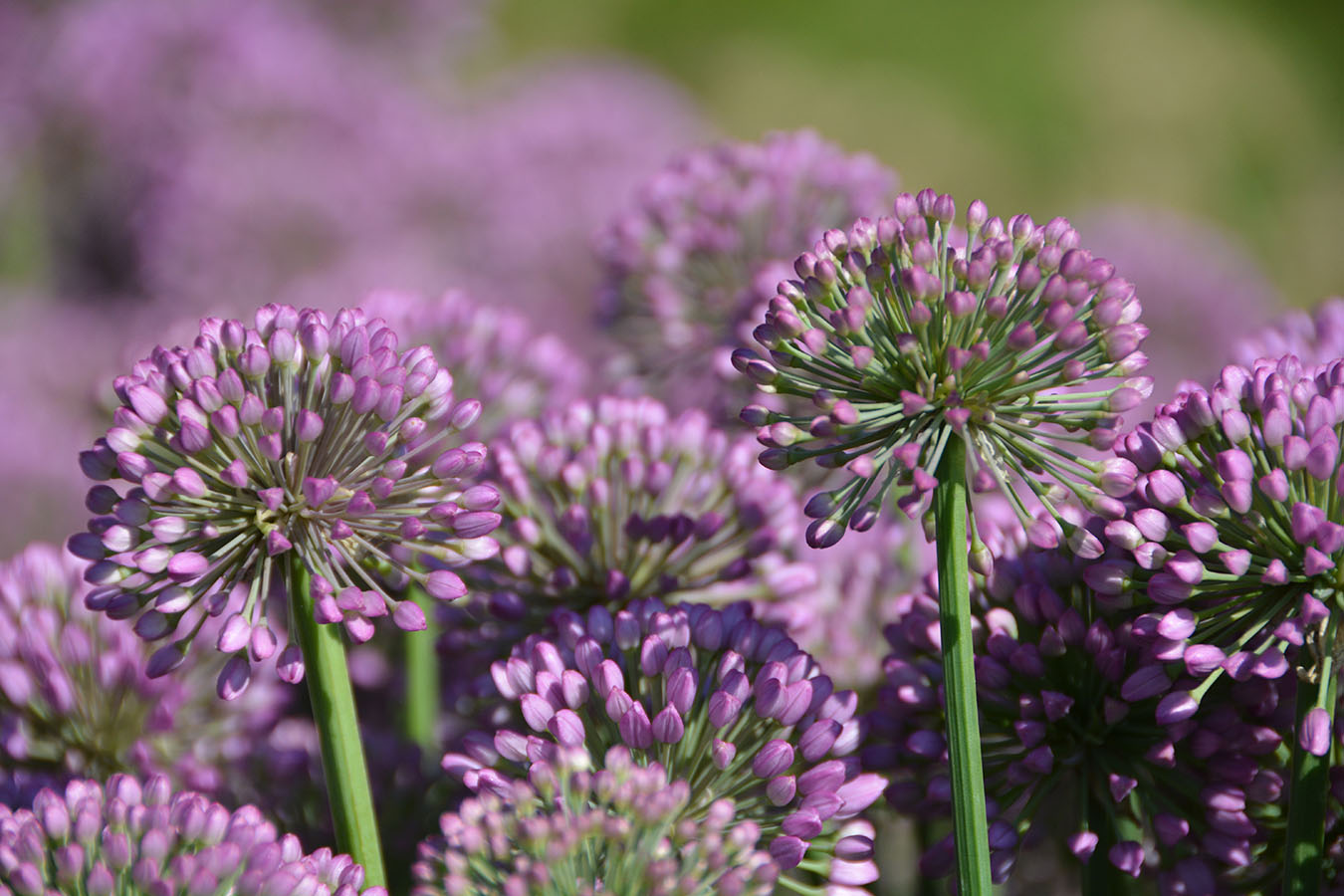
Leucanthemum ×superbum ‘Cream Puff’
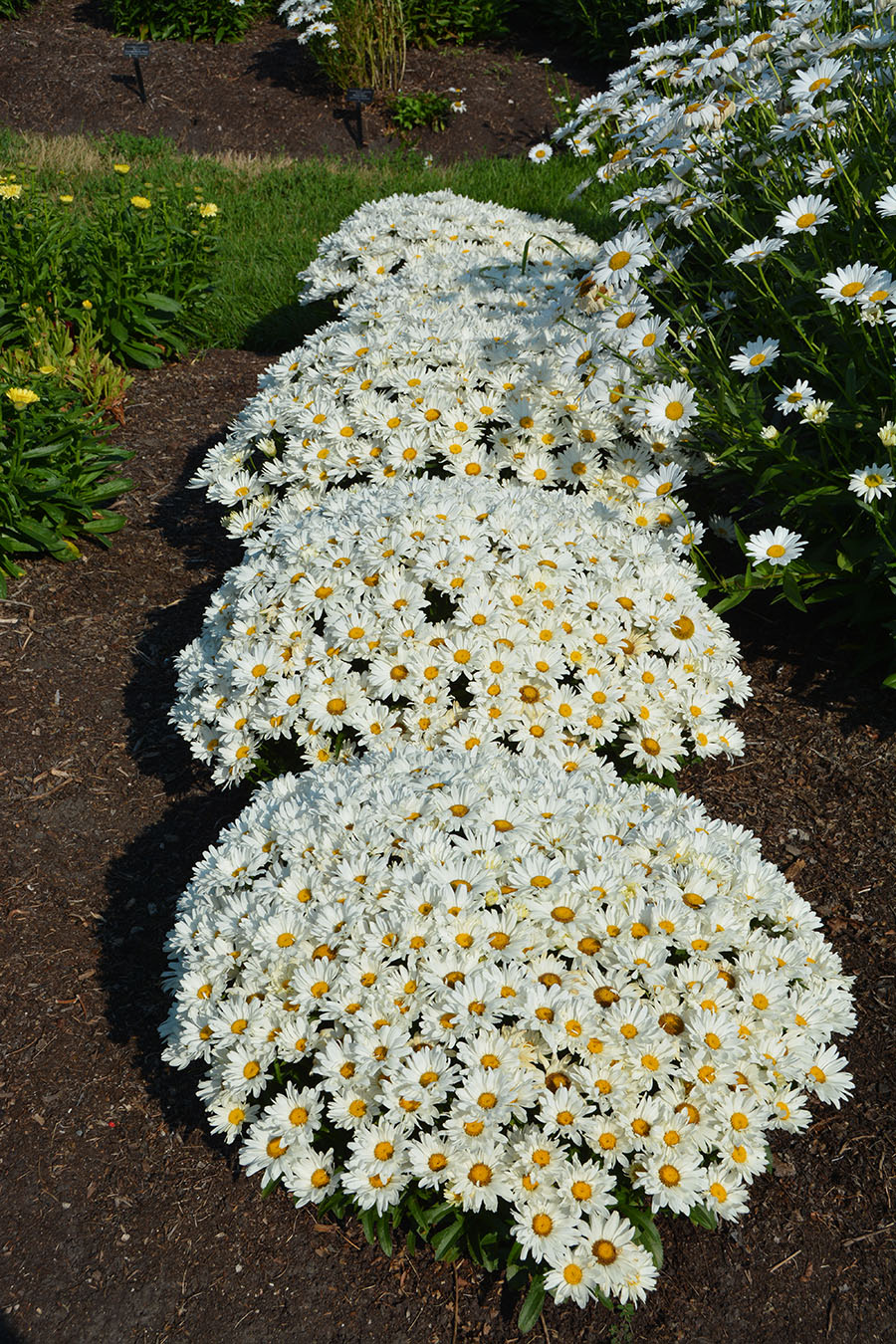
Size: 20” tall by 29” wide. Flower size: 3⅛” across. Bloom period: mid-June to early July.
‘Cream Puff’ has a similar weight to ‘Serendipity’. They both are bursting with flowers to the point where it feels like if you added one more they would explode. On both plants, all the blooms open in perfect synchrony. Like ‘Serendipity’, ‘Cream Puff’ has distinctive coloration. True to its name, the buds open a soft yellow, then the flower ages to creamy white. It gives the impression it could support your weight like a little cushion.
Calycanthus ‘Athens’
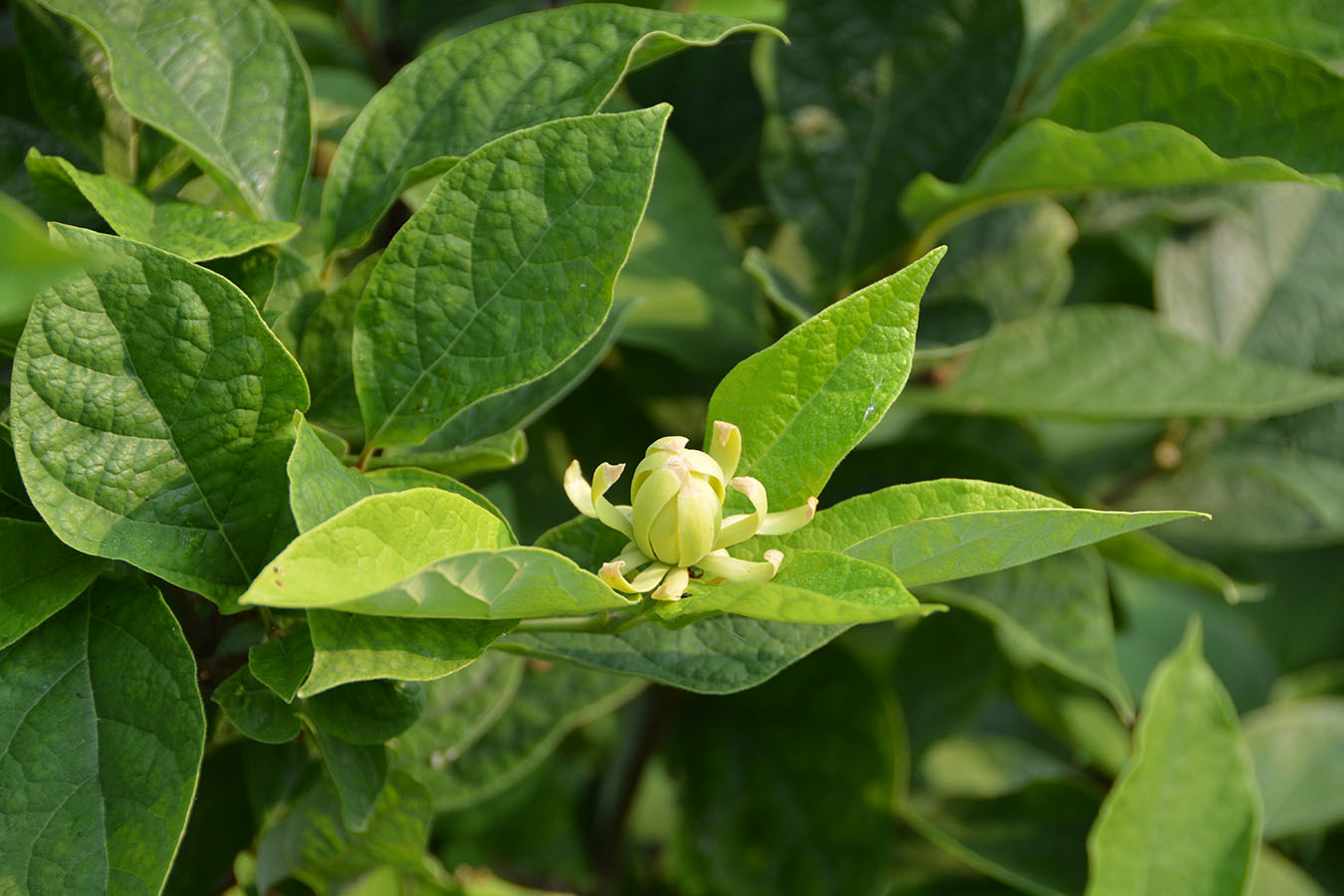
Size: 53” tall by 81” wide. Flower size: ½” tall by 1½” wide. Bloom period May-July with peak in late June.
The smell of sweetshrubs has become one of my favorites. Every part of this plant is fragrant, but the fragrance of the flowers vary cultivar by cultivar. ‘Athens’ has my favorite flower fragrance. These little green-creamy white flowers smell citrusy, soapy, and a little like bone. I highly recommend coming to the plant evaluation garden next June and smelling the different groups. Finding ways to describe the smell is pretty entertaining.
Liatris ligulistylis ‘Butterfly Magnet’
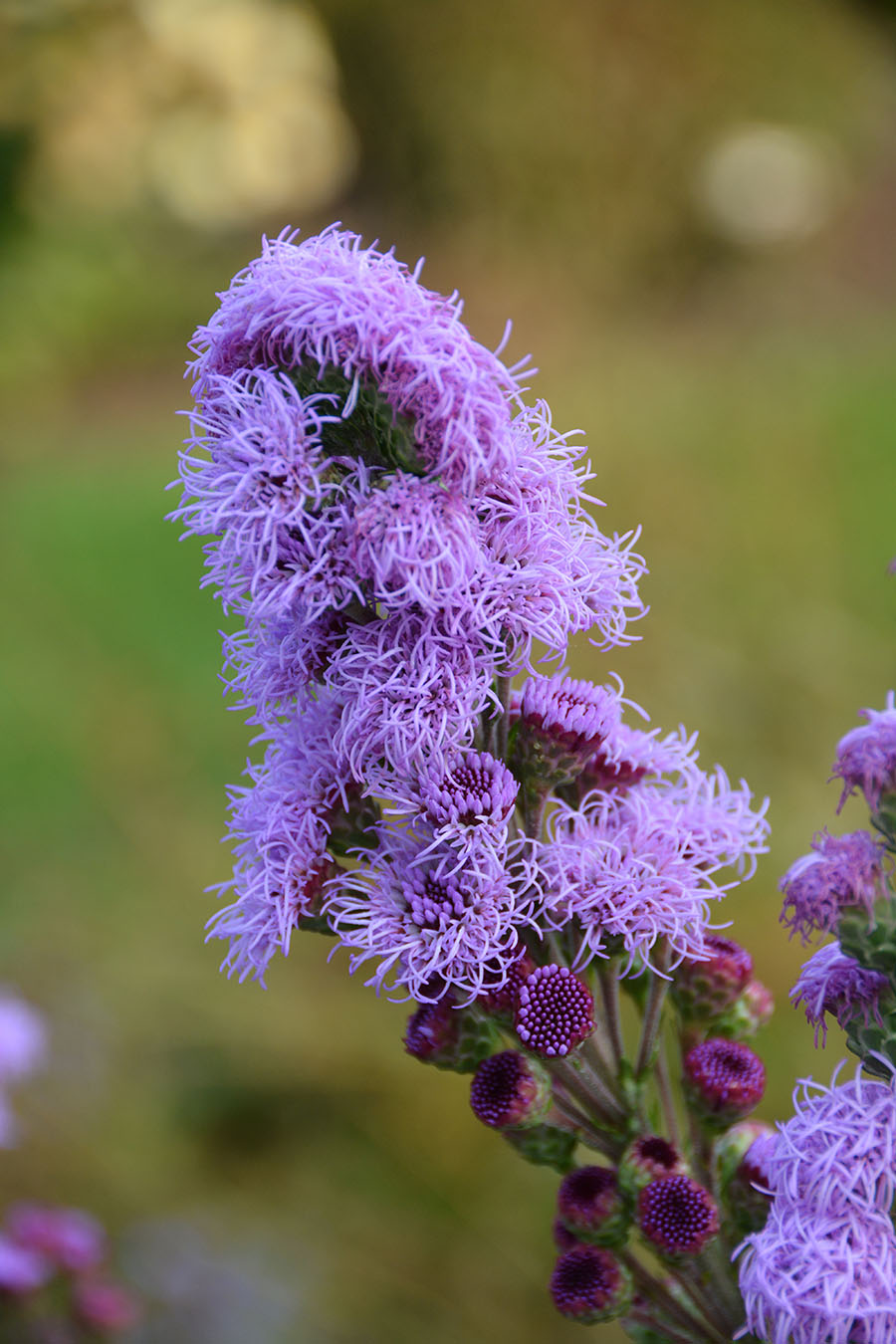
Plant size: 53” tall by 14” wide. Flower size: 1”. Bloom period: mid- to late July to early August.
I mentioned ‘Butterfly Magnet’ in a previous post because it has been the center of a controversy in our program. I think it has a strong and distinct scent but just about everyone else I’ve asked thinks I’m making it up. We are currently at eight people who don’t smell anything significant and two who do. I’ve decided it doesn’t matter if other people don’t smell it because I love it, and so do the butterflies. It has a powdery almost heady scent alongside a ton of purple flowers, some with beautiful fasciation. See if you can smell it if you walk through the garden during July.
There were other plants I liked or even loved this season, but these are the plants that hit me like a ton of bricks when I saw them. Entranced and obsessed is the only way I can think to describe how I feel about them. When I talk about them I get gushy. They. Are. Incredible.
Now wrenching myself into a slightly more objective headspace, I recognize that my list is different from Richard’s (my supervisor) or Janice’s (our volunteer of 20 years). I’m choosing six of over 950 taxa, many of which are breathtaking. As such, this is more a window into my aesthetic sensibilities than it is a definitive ranking of the absolute best of our trials this year.
In my first blog entry, I address this gut reaction as one of the facets of my evaluation and I stand by that. But I think the added nuance of that feeling being my own and not being shared by everyone is important to consider even if it doesn’t necessarily change the data I collect.
I’m excited about the plants in the trial garden. I’m invested in my favorites but I’ve been told no two years in Chicago are the same. This year our burnet trial suffered from the drought conditions and 75 percent of them collapsed before they were fully flowering, a vastly different outcome from last year. I know there is the potential for plants I’ve written off to floor me and the plants I love to fail. On top of that there will be whole new groups of plants (Umbelliferae trial anyone?) I haven’t seen before.
You better believe even if I don’t figure out a way to stick around that I’ll be pestering Richard for updates on how it goes and hoping y’all will come check it out. Keep a look out for Plant Evaluation Notes and other publications from this program during the winter time! For now, that’s all folks.
Examining flowers …
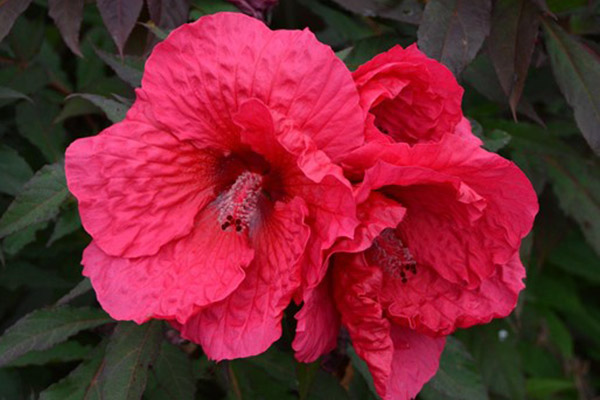
Hibiscus ‘Blackberry Merlot’
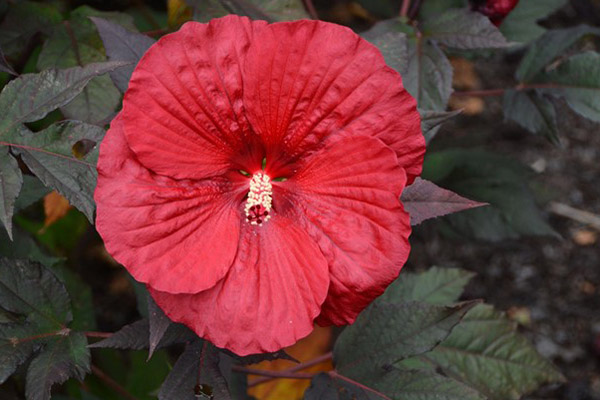
Hibiscus ‘Vintage Wine’
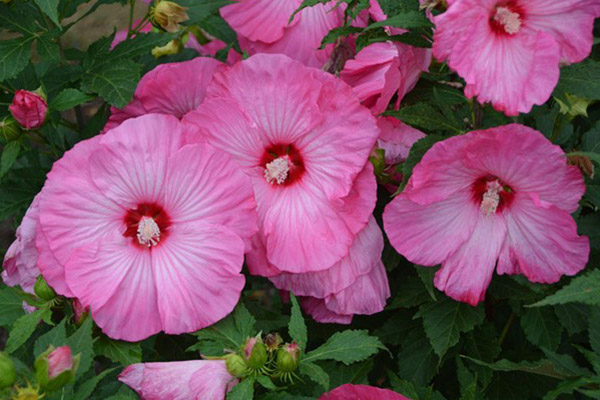
Hibiscus ‘Airbrush Effect’
In a word, hibiscus flowers are showstopping. They come in a variety of forms and colors, and the current trial at the Bernice E. Lavin Plant Evaluation Garden represents the “cutting edge” in hardy hibiscus breeding, yielding large flowers with overlapping petals and a better capacity for self-cleaning of spent blooms. These large, showy blooms also serve as a great example of how the plant evaluation team evaluates flower shows.
Hibiscus flowers are short lived (think daylilies, Hemerocallis). They are edible raw and can be used as a colorant or a tea.
Like the foliage, which we talked about in a previous post, the flower’s aesthetic value is the result of an amalgamation of traits, including size, rigidity, shape (cupped or flat), color, and how it complements with leaf color. However, to determine the overall value of a flower show, you have to balance the value of the flower itself with two other metrics: percent of flowers open (which buds have opened) and overall flower coverage (how much of the surface area of the plant the flowers cover). The evenness of the flower distribution is important as well. Uneven flower distribution or blooming can lead to a distinctly patchy look.

Figure 1 - Top down view of 25% open flowers. Green dots are buds, red dots are flowers. 25% of the total number of buds are open as flowers.

Figure 2 - Top down view of 40% flower coverage. Like Figure 1. Still 25% of flowers are open but now the buds and the flowers are to scale demonstrating that even though 25% of the flowers are open they cover 50% of the plant.
Flower percent and coverage are what we track during a plant’s blooming season. As we track this range, we are also trying to capture the peaks of each cultivar group. At what point does it look its best? Each group will have its own peak bloom coverage and the cultivar groups that look the best often have the highest coverages. Because of the way hibiscus blooms and the longevity of its flowers, they will never all be open at the same time—imagine all of the buds opening at once into blooms with an 8-inch diameter.

Bud Coverage: Green dots indicate buds, with A) even bud coverage of 100%; B) uneven coverage of 50%; C) tightly clustered buds on Hibiscus ‘French Vanilla’.
Consistently capturing how many blooms are open, how much area they cover, and how many are left to open are key to accurately describing how a plant blooms in a season. This applies not only to hibiscus but also to all the plants we evaluate that have decorative flower shows. The details of the flower may change, but the core goal to capture the intensity and duration of a display remains the same.
… And the joys and challenges of the job
I’ve focused a lot about what I’m thinking about when trying to evaluate plants, but that doesn’t quite convey what it’s like to evaluate them.
I spend around six hours in the Lavin Plant Evaluation Garden each day, and as a result, I’ve gotten to know the inhabitants and regular visitors to the garden. I’ve had some lovely conversations with the photographers looking for hummingbirds on the torch lilies (Kniphofia) or hummingbird moths on the butterfly bushes (Buddleja). On the other hand, territorial red winged blackbirds are less friendly.
The engaging puzzle of analyzing and evaluating plants both reveals and complements the ever-changing conditions of the Plant Evaluation Garden. In the morning, as the early morning sun breaks over the Daniel F. and Ada L. Rice Plant Conservation Science Center, the bees wake up, and the breeze wafts the smell of the fragrant ‘Butterfly Magnet’ (Liatris) through the garden, it can be peaceful and relaxing. Or, at noon, I might hear the warning sound of a blackbird, which makes my blood run cold despite the UV index of 10 and the sweat dripping down my back.
It is a rich and rewarding experience to get the opportunity to know this space so well, regardless of my eternal enemies. I would even say that the fear that the blackbirds have instilled in me is part of what makes it so rich. The diseases, the pests, and those protecting their nests are important parts of the ecology that makes up the garden. Knowing them means I have a better and fuller understanding of where I spend my time.
What foliage color tells us about hardy hibiscus
I am the new intern in the Lavin Plant Evaluation Garden, where our plant evaluation program has been developed over the last 36 years by plant evaluation manager Richard Hawke. I’m working with Richard to gather data that will help us determine how the individual varieties rate when considered for hardiness, ornamental quality, and pest and disease resistance. In a series of posts, I will give a glimpse into that evaluation and what we are seeing this year.
Of the 18 genera on trial this year at the Plant Evaluation Garden, hardy hibiscus (Hibiscus moscheutos and hybrid cultivars) is the one I’m the most excited for. Somewhat inconspicuously tucked in the shade by the edge of the Trellis Bridge, where you might do battle with red-winged blackbirds, these bushy plants hold the promise of an explosion of color and texture from their multicolored foliage.
Depending on the genus, we care about different specific traits. These traits derive from known pest and disease issues and the current direction of breeding for a given group.
In this round of evaluations of hardy hibiscus, I am documenting and comparing foliage among our 34 cultivars. Foliage color includes a wide swath of greens, burgundy, and cream.
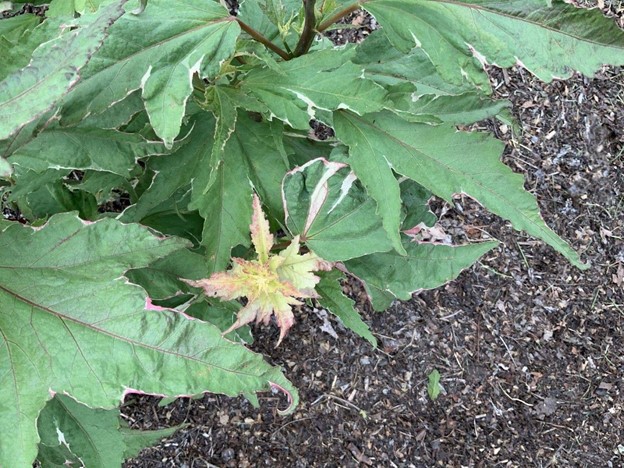
Hibiscus ‘Summer Carnival’
When I’m standing in front of a plant and gathering data, my goal is to accurately represent the plant’s whole state at that moment. That can feel like a monumental task, but the value of the comparative trial structure we use is that variation of a trait amongst the members of our trial helps develop a vocabulary that allows us to pick out specific differences between plants.
To apply this to the foliage of hibiscus, one of its primary qualities is the amount and type of burgundy in the leaf. I use a 1 to 10 scale to describe the quantity of burgundy in a leaf, letting me say, “This leaf is a burgundy 6/10, and I like it better than this other one that is a 4/10.” Following the same idea, there is variation in leaf form, with some cultivars having deep lobes and others being unlobed. Finally, some cultivars have unique characteristics, distinct venation, unusual shades, or variegation. These attributes create the character of a leaf and are what I’m trying to articulate and convey in my data collection.
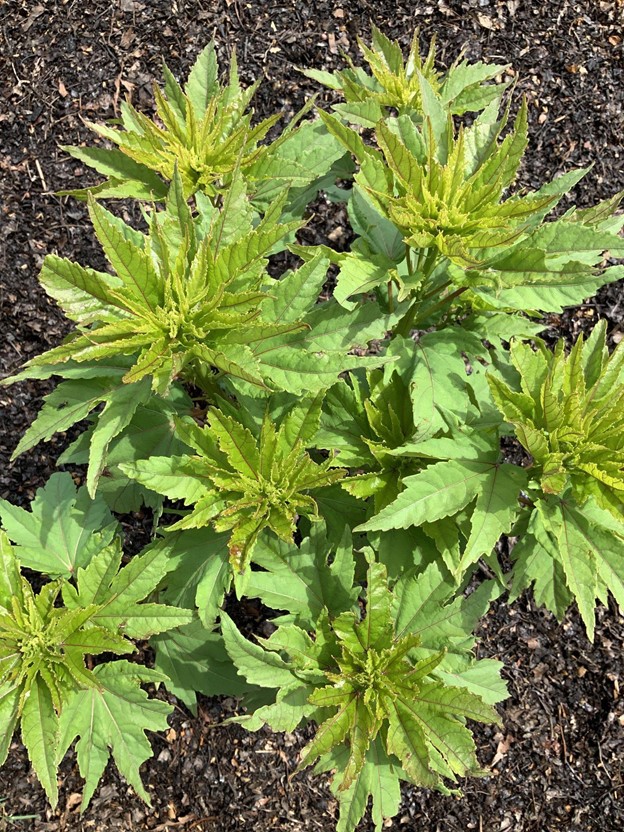
Hibiscus ‘4385’ SUMMER SPICE™ Plum Flambe
My personal taste for hibiscus foliage is for ones that have almost equal parts burgundy and green, especially when the green has an emerald quality to it. At the same time, I prefer leaves that have more subtle lobing.
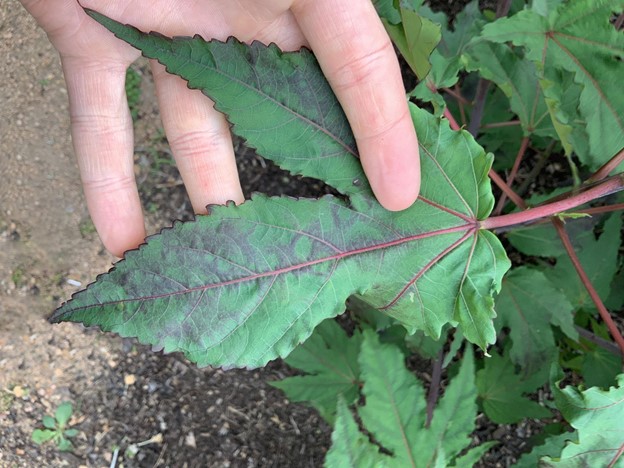
Hibiscus ‘Plum Fantasy’
This brings up an important point: There is an aspect to evaluating that gets lost when only thinking in such clinical terms. Someone will come up to me while I’m evaluating, and we’ll start talking about what I’m looking at, and I end up going on and on about my favorites. I’m not checking my notes but instead running from one to the next, exclaiming how incredible this plant is. I have strong opinions, even if I’m seeing a plant for the first time.
For all the hyperbole I use in these conversations, a plant’s ability to elicit this kind of reaction matters and so becomes a part of the evaluation.
In the end, it’s these two facets of the evaluation—gut reaction and the desired traits gathered from data—that I’m trying to capture at a series of key points over the span of time in the evaluation garden. This record of the plant's life and how I felt about it becomes the data that is used down the line.
I will be sharing more about the process, and the unexpected discoveries, in future posts. If you think the leaves are cool looking, wait until you see the flowers.

